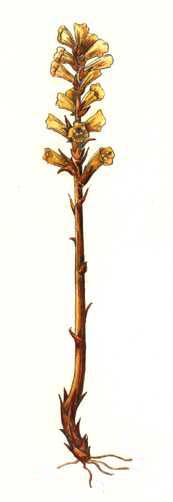Weeds
Orobanche aegyptiaca Pers. - Egyptian Broomrape
Systematic position.
Family Orobanchaceae, genus Orobanche L.Synonym.
Phelipanche aegyptiaca (Pers.) Pomel.Biological group.
Annual parasitic plant.Morphology and biology.
Stem 15-50 cm, usually branched, yellowish, up to 6-8 mm thick in its midsection, with slight thickening at base, with some ovoid-lanceolate scales up to 15 mm length. Plant covered with short, glandular hairs, sometimes almost glabrous. Inflorescence cylindrical, friable, almost equal to or longer than the rest of the stem, up to 25 cm in length. Corolla 25-35 mm in length, tubular-infundibuliform, considerably broadened, almost erect, blue-violet or sky blue, lighter at base of tube, whitish, covered with short, sparse, glandular hairs outside, glabrous inside. Calyx 8-14 mm in length, usually very light, whitish, covered with short, glandular hairs. One plant produces over 1 million seeds every year; the seeds maintain their germinating capacity in soil for a long time under favorable conditions. The parasite prefers cultivated (rarely wild-growing) plants of more than 90 species in different families of flower plants (except monocotyledones).Distribution.
Lower Volga, Crimea, the Caucasus, Central Asia (in the former USSR), the eastern Mediterranean, Central Asia and Asia Minor.Ecology.
The parasite occurs in fields, in watermelon plantations, in wild-growing plants, usually near roads and along field edges, rarely on stony slopes.Economic significance.
This is the most dangerous parasite of all broomrape species. It parasitizes melons, cucumbers, watermelons, pumpkins, tomatoes, red pepper, eggplants, potatoes, maize, tobacco, groundnut, and, though more rarely, sunflowers, cabbage, mustard, radish, carrots, and sesame. Main control measures include correct crop rotation (susceptible cultures sown only every 5-8 years in fields infected with seeds of Broomrape); cultivation of varieties resistant to broomrape; weeding before production of Broomrape seeds by obligatory burning or deep burying of inflorescences; and sowing of resistant cultures (for example, soya bean, flax) on fields affected by Broomrape. The last method results in a considerable reduction of Broomrape seeds within the soil. Biological methods of control include application of the fungus Fusarium orobanches and endoparasite fly Phytomyza orobanchia.Related references.
Bronshtein, Z.G. & Kabulov, D.T. 1961. Perspectives of biological method of Egyptian Broomrape control. In: Works of Samarkand State University. Samarkand: Samarkand State University, p. 73-89 (in Russian).Kabulov, D.T. & Mukumov Kh.M. 1965. About species composition of host-plants of Egyptian Broomrape (Orobanche aegyptiaca Pers.) in Middle Asia. Nauchnye doklady vysshei shkoly, Biologicheskie nauki (Moscow: Vysshaya shkola) 2: 111-116 (in Russian).
Nikitin, V.V. 1983. Weed plants of the USSR flora. Leningrad: Nauka. 454 p. (in Russian).
Shishkin, B.K., ed. 1958. Flora of the USSR. V. 23. Moscow; Leningrad: AN SSSR. 776 p. (in Russian).
Ul.yanova, T.N. 1998. Weed plants in flora of Russia and other FSU countries. Saint Petersburg: VIR. 233 p. (in Russian).


